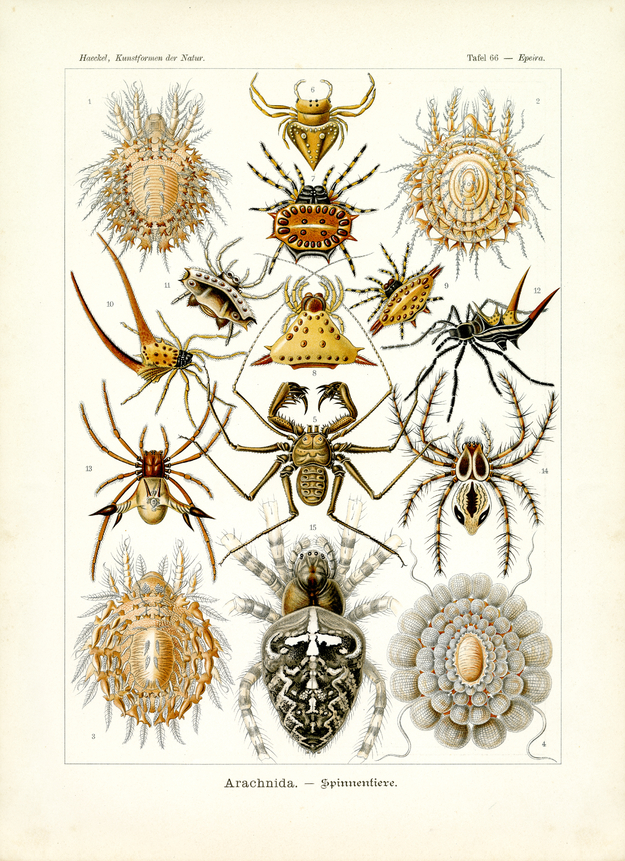Translation of the original German introduction by Ernst Haeckel:
Phylum of Articulata (Gliedertiere); - main class of Tracheata (Luftrohrtiere); - class of Arachnida (Spinnentiere).
The very diverse class of spiders (Arachnida) of which more than 4000 living species and many extinct ones are known is closest related to the class of insects. Just like in insects their body is originally structured into three main parts, head (Caput), chest (Throax) and ‘posterior body’ (Abdomen). But while in insects head- and chest-parts carry seven pairs of extremities there are only six pairs in spiders: the insects’ ‘sensing horns’ (Antennae) are missing. The oldest Arachnida, ‘original spiders’ (Solifugae), have, just like insects, three pairs of jaws fixed to their head: upper jaw (Mandipulae), lower jaw (Maxillae) and posterior jaw (Postmaxillae); similarly, the chest is composed of three rings or thorax-segments carrying three similar pairs of legs. In all other spiders the three head-segments merge with the three thorax rings into a single mass called ‘head-chest’ (Cephalothorax). At its bottom side six pairs of extremities are fixed of which the two in front are usually considered as “jaw” (upper and lower jaws) whereas the four posterior ones are seen as “breastbones”. The posterior jaws rarely retain their special shape (fig. 51); they usually assume the frame of the three real breastbone pairs contrary to insects (with three pairs of ‘leg-bones’).
The class of Arachnida is (except for the original spiders, Solifugae) organized in three major legions; out of these the legion of scorpions (Scorpionea, more than 500 species) is the oldest; the rings of the abdomen (6-13) remain separated (fig. 5). In the other two legions these rings merge into an inarticulate mass. This mass remains separated from the ‘head-chest’ in ‘weaver spiders’ (Araneae, more than 2500 species); their abdomen is at times elongated and circular (fig. 13 – 15), at times broader than longer (fig. 7 – 10), even triangular (fig. 6, 8); frequently it is armed with stings (fig. 7 – 13). The abdomen fully merges with the ‘head-chest’ into a single round mass in the case of small mites (Acarinea, more than 1000 species). These smallest Arachnida, in most cases visible only with the help of a microscope, usually living as parasites on other animals and plants, are to a large extent regressed and structured in a very simple way. Occasionally, however, in their early stages of development (Nymphs) they are distinguished by very delicate horn-like dermal appendages; see the minute ‘moss-mites’ (Oribatidae, fig. 1-4) living in mosses.
Translation by VR Translators Bangalore
We've scanned the original lithography at 1200dpi on the Epson A3 scanner of A3 scanner huren. You can download a 400dpi JPEG here.
